Found a Monarch caterpillar on my milkweed!
Every year around this time as the Queen butterflies start to show up, we get lots of questions about how to tell the difference between Queens, Danaus gilippus, and Monarchs, Danaus plexippus. And with the warm weather that has gripped South Texas throughout November and now December, many of us are still finding eggs and caterpillars in the leaves of our milkweed. Queens are here en masse.
As it turned out, the caterpillar in question that my friend Hugh texted me about (excuse the typos) was in fact a Queen. The giveaway: it had three sets of protuberances, rather than two. These protuberances are often referred to as antennae, but they are actually a type of sensory organ called tentacles. Most caterpillars–including Monarchs–have a set of tentacles at the front of the body and another at the back, but others–like Queens–have another set somewhere in the middle. Tentacles help caterpillars sense the world around them through touch, and can also throw off predators by disguising the caterpillar’s head. Caterpillars also have antenna, but these organs are far less obvious and helpful for identification. The antennae are short, spiky projections on either side of the caterpillar’s mouth.
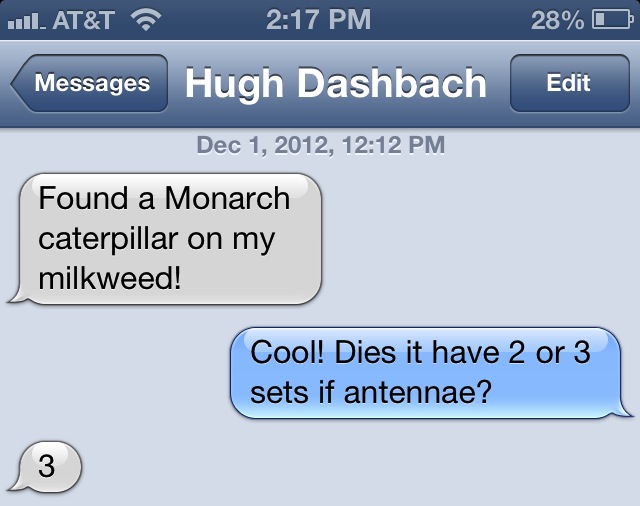

Queens on Purple Mistflower
Hugh’s confusion is common: because of their similar color, size and affinity for milkweed as a host plant, Queens and Monarchs are often mistaken for each other in their various life stages.
But once you look closely, it’s not that hard to tell the difference between Monarchs and Queens.
First, Queens appear solid orange compared to the varying shades of a Monarch. In the photo above, notice how with their wings folded, the Queens’ solid dark orange is interrupted with occasional white dots–nothing like the striking stained glass veins and color pattern of the Monarch below.
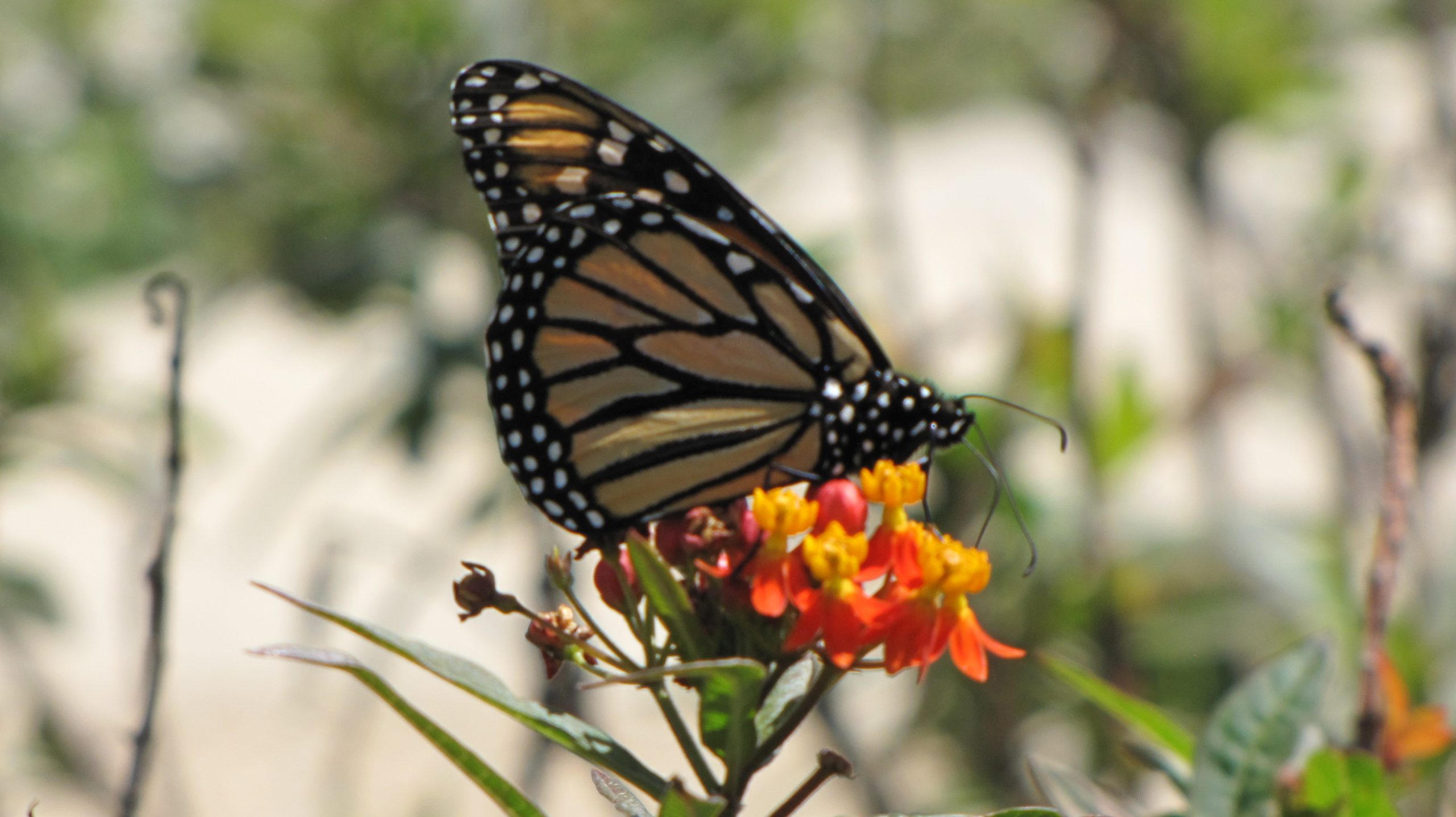
Monarch butterfly on the San Antonio River Museum Reach
With their wings open, the difference is even more obvious. The Queen is solid, the Monarch has varied coloration. Both of the examples below are male butterflies, as you can see by the prominent display of their family jewels–the defunct pheremone sacs that presumably once drove the lady butterflies wild.
Female Queens and Monarchs don’t have these prominent markings with wings open. In Monarchs, the black veins are generally wider and more pronounced in the females.
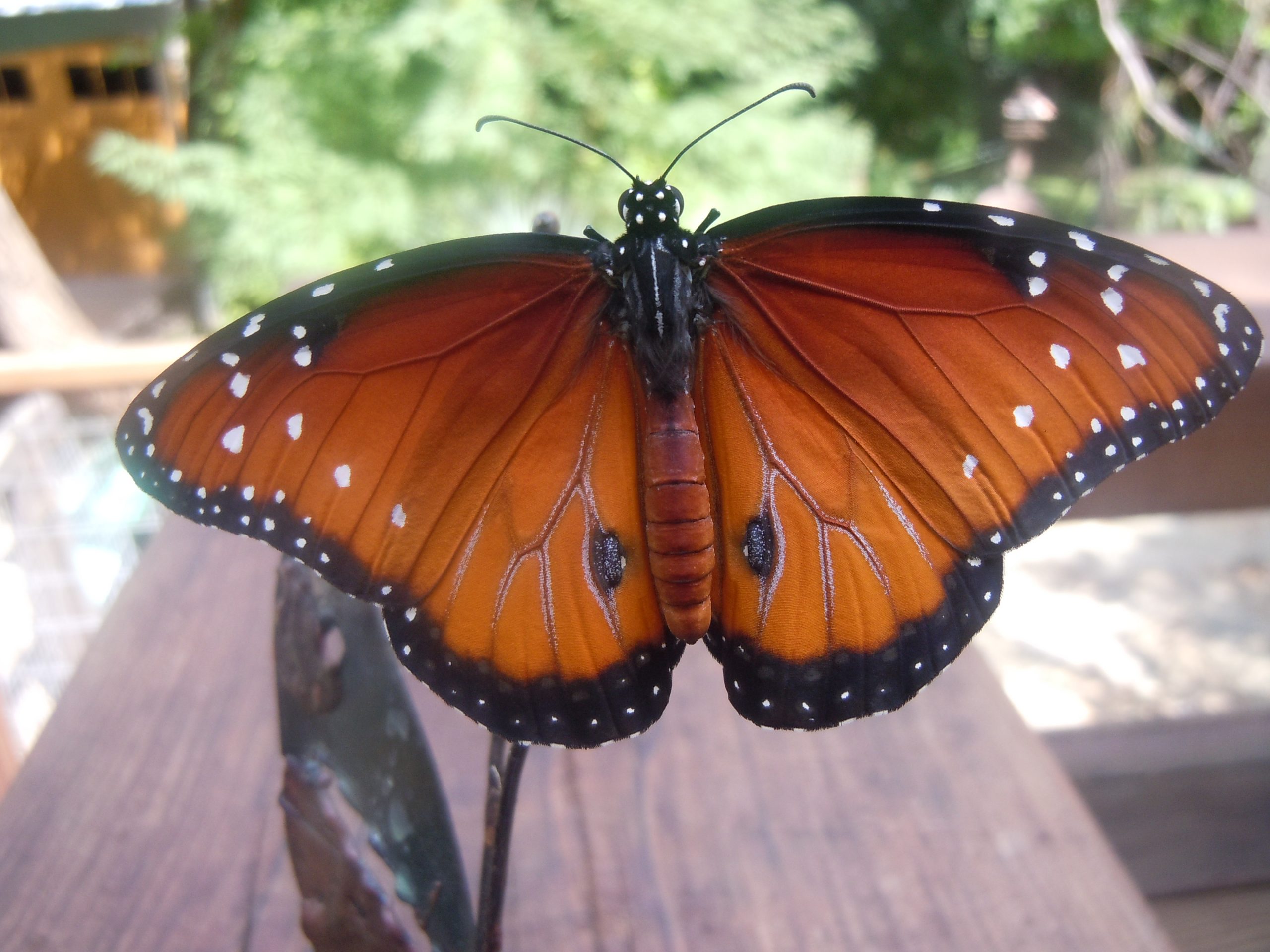
Queen butterfly. It’s a male.
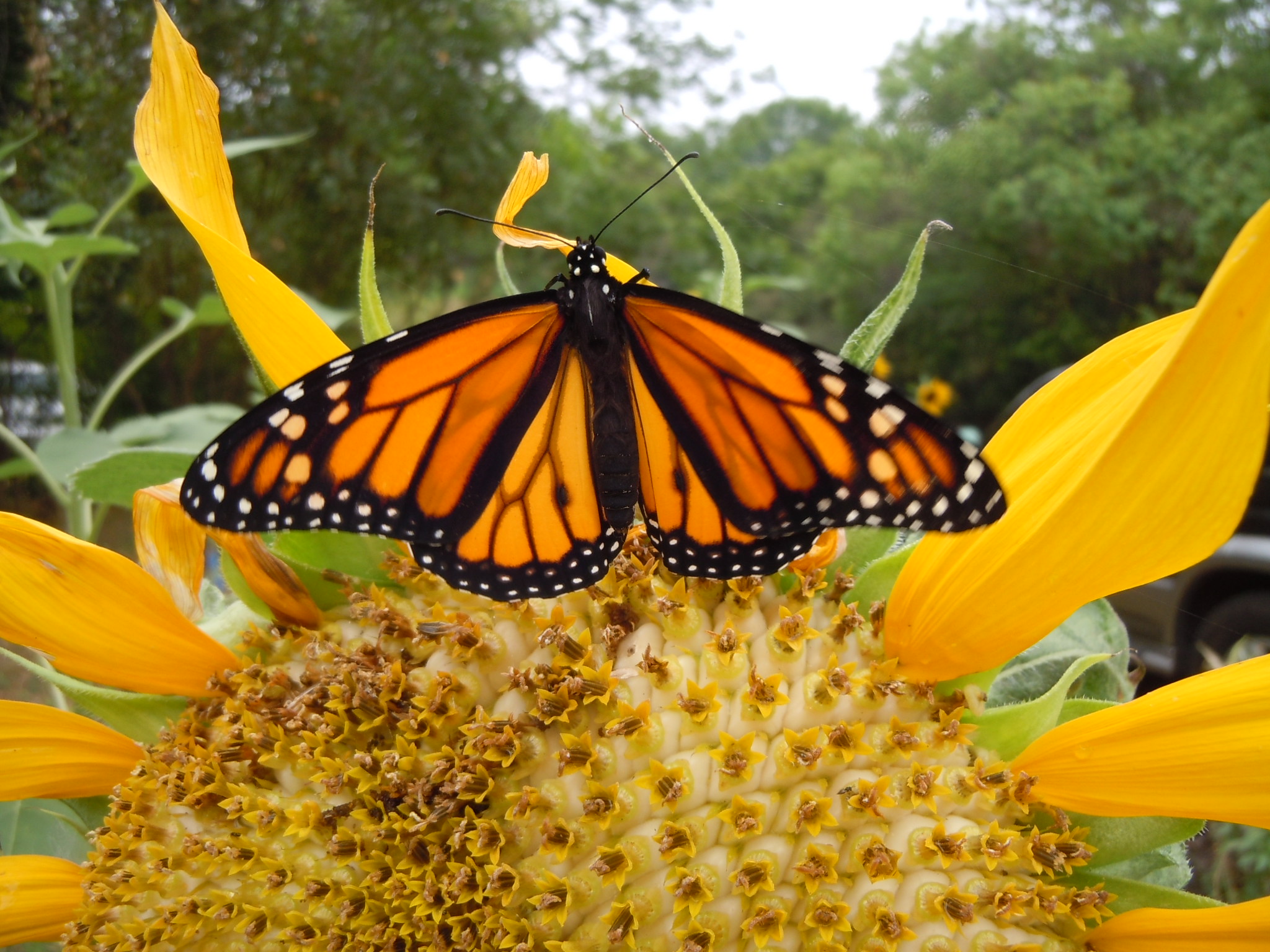
In the caterpillar stage, the most obvious difference is that Queens have three sets of tentacles, while Monarchs have two sets.
Notice in the photos below, the Queen has what appear to be THREE sets of protuberances. The Monarch caterpillar only has TWO. Both wear distinctive yellow, black and white striped suits. The Queen often will have a slight red blend as the tentacles connect to the caterpillar’s torso. The patterns of the stripes can vary depending on time of year, humidity and diet.
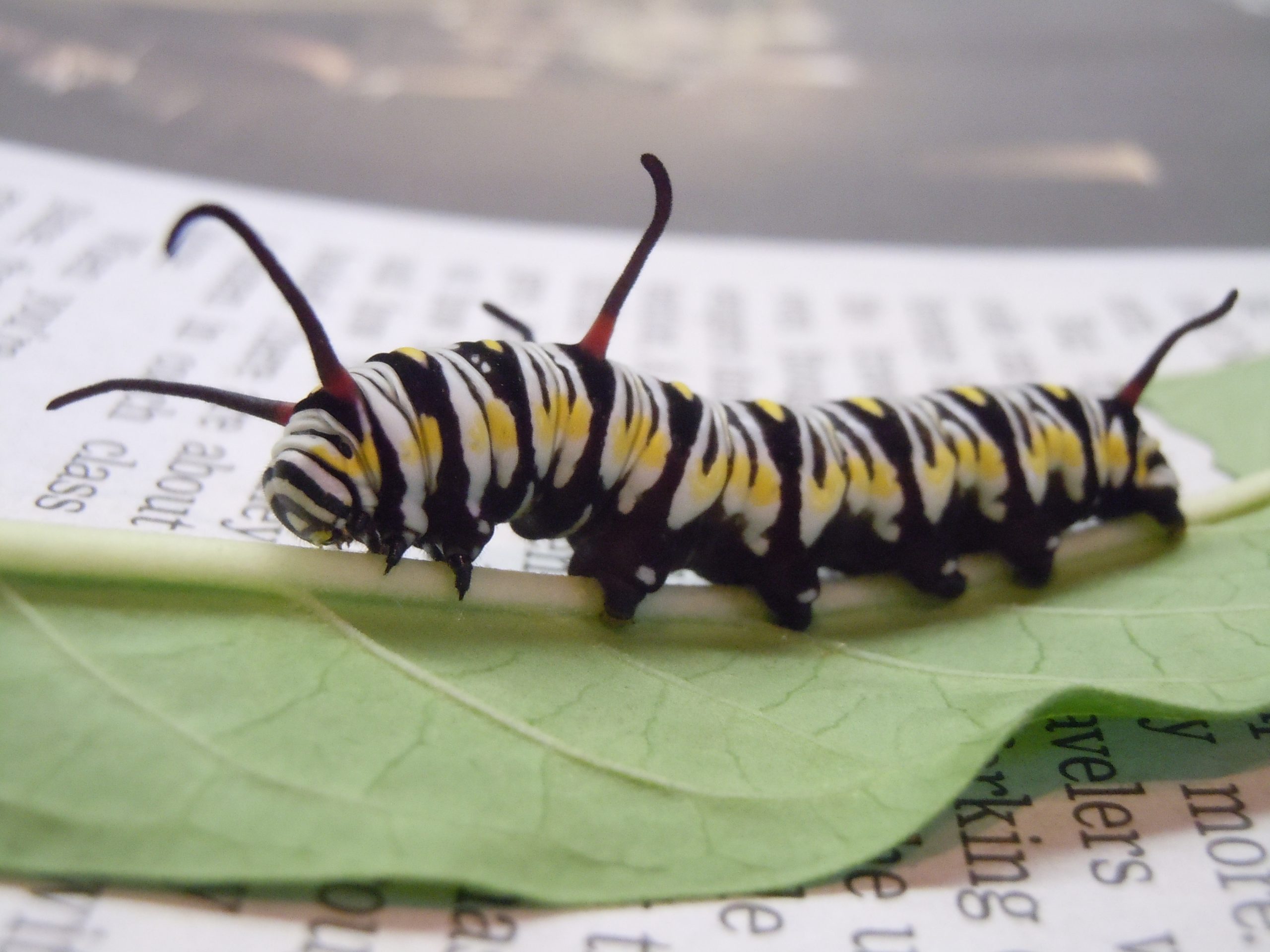
Queen caterpillar sports three sets of tentacles.
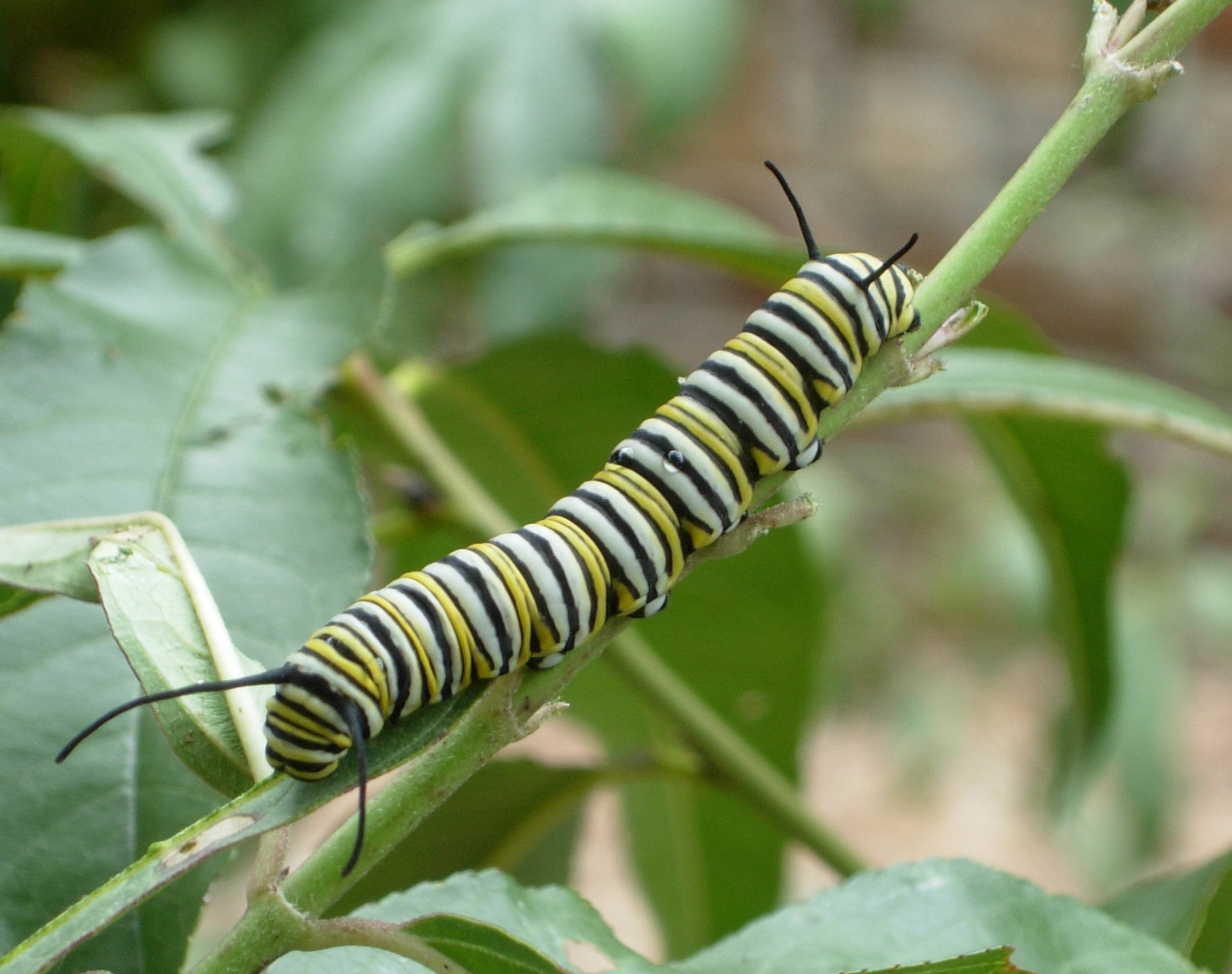
Scientists don’t fully understand the biological purpose of the tentacles, which seem to reach out and “feel” the universe around them. They swerve and turn in various directions, almost punctuating caterpillar moves like a roving eye or arched eyebrows on the human face.
For the sake of identification, let’s just say their purpose is to signal the difference between Queens and Monarchs. For more on filaments and what we do and don’t know about them, check this link on the Monarch Watch page.
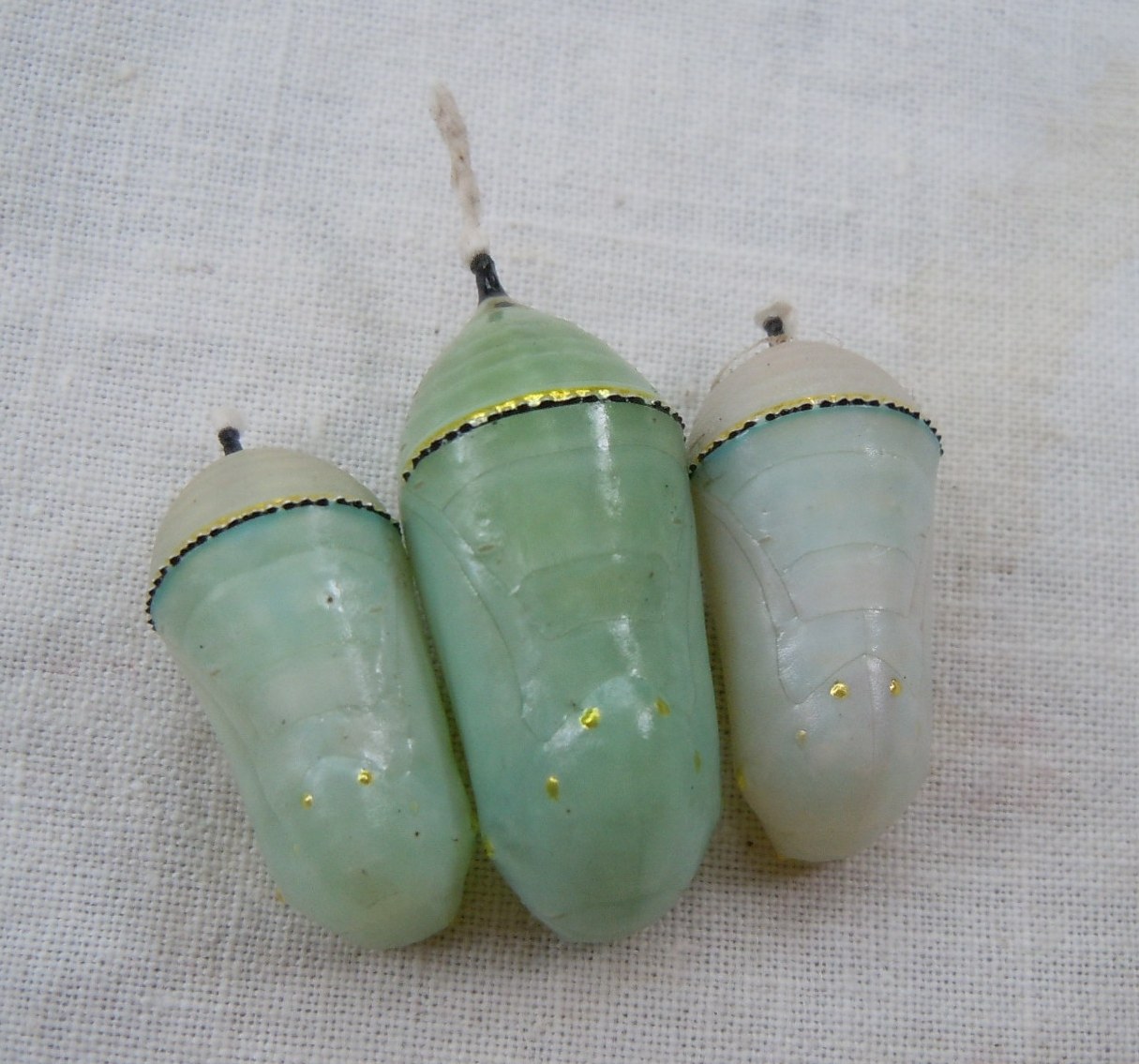
Queen and Monarch chrysalises. Monarch in the middle.
Like what you’re reading? Don’t miss a single article from the Texas Butterfly Ranch. Sign up for email delivery at the bottom of this page, like us on Facebook, follow us on Twitter, @monikam or on Instagram.


Appreciate all of the pictures and information about butterflys. When possible, can you place some object, like a key, in the pictures for size reference?
Mine is 1 inch long
I have been raising monarchs for several months, and have found what appears to be a monarch caterpillar with 2 antennae, 2 sets of filaments immediately behind that, and the tail filaments, for a total of 8 antennae/filaments. Other than that it appears to be longer than usual, but the same monarch colors. Do you recognize this? It is nearly ready to turn…I have never seen one like this before. Any clues?
Do you have a photo?
Is there a difference between orange monarchs and the yellow ones? Besides colour?
Are you sure the “yellow ones” are not actually tiger swallowtails?
I found a caterpillar on the greens, of a carrot. My five year old and I have been feeding it in a commercial net butterfly garden. It looks very much like a monarch caterpillar but when touched, on the face, two yellow antennae extended and retracted. Any clue what it might be?
Sounds like a Swallowtail. See this week’s blogpost: https://texasbutterflyranch.com/2014/07/01/how-to-raise-eastern-swallowtail-butterflies-at-home/#comment-181176 .
Appreciate all o the info about butterflies, very helpful.
We are doing a monitoring on the migration route in Tamauipas Mexico and your info is excellent. Thanks!
Are Queen cats less resilient to hot temperatures than the monarchs? I had 5 queen caterpillars in my butterfly house and about 4 monarch cats. All of the monarch cats have survived so far, but I only have one Queen left. The others just stopped responding and quit eating and growing. Just lifeless. It’s in the mid 90s here in South Texas. I keep the habitat in shade under the patio.
Monarchs in Massachusetts have been scarce in the past two years. Before this I have raised and released about 250 Monarchs a year. I have butterfly bushes and milkweed plants in my yard and many other kinds of butterfly plants, yet they have declined. I have promoted to others that milkweed needs to be left alone when found and not pulled up. We do have other butterflies like Swallowtails visit and plant their type of food. Now, it is up to people to demand that Monsanto-like chemicals be stopped if we want to continue to see all butterflies.
Living in Mass. usually means your winters make the milkweeds go into dormancy. Don’t pull up milkweeds. Depending on the age and type of milkweed you have they will either “die” back all the way down to ground level or they will just lose their leaves. If yo want to blame Monsanto or any of your neighbors for spraying insecticides look for caterpillars throwing up of having diarrhea. Otherwise their frass (poop) should look like a black piece of Grape Nuts. Remember that only 10% of eggs grow up to be butterflies.
I will receive some of this summer’s milkweed now erupting from their pods.
In order to be planted, do the seeds need to undergo “cooling in the refrig” for
seed maturation?
Not just cooling, but actual freezing seems needed. I plant the seeds in pots in the fall and leave the pots outside for the winter (Connecticut). Then up come the seedlings in April! They hate being transplanted so get them quickly into individual pots so they can establish their own roots before putting in the ground.
FWIW I’d like to add a comment regarding “diarrhea” in caterpillars. Years ago, in addition to monarchs and swallowtails, I reared a few species of saturniid moths, and I realized quickly that the moth caterpillars exhibit a form of “diarrhea” shortly before spinning their cocoons. At first I was alarmed, but then after the adults emerged normally, I realized this is simply another part of their life cycle that differs from that of the butterfly larvae. I guess the moth larvae simply need to “empty” their digestive tracts before pupating!
Note that the two anterior filaments are not antennae. The antennae are actually minute structures just above the mandibles.
Thank you from Miami. You helped be to identify my newest visitor. I have queen caterpillars on my monarch’s milkweed. 🙂
I found eggs on my milkweeds last night. I know for sure 3 of them look just like my monarchs from last year but I have many many more that look the same except they are smaller. Could these be queens? Or another type of butterfly? Or do monarchs sometime lay smaller eggs? Thanks!
If we’re not to blame Monsanto’s Round Up, then what other explanations are there for the huge decline in Monarch migration?
I m raising my first monarchs. So amazing. Enjoying your info I am in Ohio.
Thanks for this article. I have some nearly ripe Monarch ‘pillars, and I found a few itty bitty ones. The itty bitties had an extra set of “feelers” and I wondered if they had been parasitized. Glad to know it’s perfectly normal…for a different species. I try to always have something in bloom – lots of lantana, milkweed, and pentas – to invite in all of the nectar-ers an pollinators.
Scroll down on my caterpillar page and you can see a close-up pic of the location of Monarch antenna:
http://www.martydavisphotos.com/monarch-butterflies/larva/
I saw my first Queen Butterfly today with Monarchs on milkweed in Northeast Texas. Are Queens rare in this part of Texas?
I have tons of Queens in my yard here in Bedford, TX. They’re also plentiful in the Hill Country. Plant Greg’s Blue Mist flowers …. they’ll swarm to it in the late summer.
How long will a queen stay in crysalis form? I have had one hanging in my butterfly tent for 2 or 3 weeks. I was thinking it would eclose in about the same time as a Monarch. Am I wrong?
This website is awsome! I do have a question, 3 days ago I got my first male Queen Monarch. It did not have the black dots on the middle bottom of the wings. Today I got another one! This one did have the black dots on the bottom of the wings! I think this one came from an all pink chrysalis! Can this be possible? Obviously this is a male and female. What would be the correct name? Male male Queen Monarch? I’m confused, they did come from my milkweed plants.
Any info would be greatly appreciated!
This is my 3rd year raising the monarchs. My total healthy releases are 1,881 as of today!
Have two out of 5 queen chrysalis with butterfly coming out with deformed wings. Sad. Is this preventable.
Location is south fla gulf coast during a rainy season, but caged and fed inside.
Thanks for this website with great pictures. I am in Tucson and have been planting milk weeds around my property. Yesterday noticed that I have both Monarch and Queen caterpillars eating from some of the nonnative plants. I am so pleased!
I have two chrysalis both small compared to the others and light colour but the caterpillar did not have the third set of antenna. I do have a caterpillar with a yellow face and yellow legs. Can you explain.
I wish there was a phone number i can call with my questions and problems. My heart broke when i had to euthanize one last nite. The wings never developed. Now i brought the rest of my 15 chrysalises indoors because its rainey and low 60’s. Dont know if i should put a plant light on for them or should i mist them etc.
There are wonderful Facebook groups that are great quick resources when you have questions. The Beautiful Monarch is one of them.
[…] The queen butterfly, commonly mistaken for a monarch, was also seen many times, marked by its bright orange and black wings with white spots. The difference: the wings lack the stained-glass appearance particular to the Monarch’s. […]
I love Hugh Daschbach! His wife was my teacher and he is great friends with my parents! Really fun to see his name in this article as I read about my new Queen! I was curious what the chrysalis would look like. Thanks for the interesting article!
I love me some butter flies
Remember doing a project in school about butterflies
Thanks for the information! I’m curious, I set 32 Monarchs free this past summer. Now I have monarch catapillars AND Queen. Can I keep them in the same habitat , or do they fight? I use the net enclosures to keep the Tachinid Fly away. I’m in San Diego, CA. Thanks! 🐛🦋
Thank You very much for this information. I was just in the garden looking at the milkweed (taking over the vegetables) and noticed the usual great display of butterflies and bees, there were a couple of caterpillars and I was not sure if they were Monarchs, with only 2 sets of protuberances I now know they were Monarchs. Keep up the good work Glen Denver Nova Scotia
Great article! I raise and release every summer. I haven’t seen many Monarchs in Northern Michigan this year but eggs are plentiful and that’s how I do mine. About it was stated that only 10% of eggs make it to Butterfly, and I disagree with that, most of my eggs hatch and make it to butterfly. I keep counts on what I put into my tents,don’t house new hatchling with any cats over 2nd instar to reduce accidental consumption of hatchlings and I do counts for loss. I’ve had a few each summer disappear but I don’t count them out until I have a tent full of chrysalis and no cats. Usually if you check dried leaves you will find your tiny cats in a roll of a dry leaf. I do this so as not to throw the baby out with the bath water. This method has increased my release numbers rather than bringing in cats that I find. I only rarely bring in a 3rd instar or later but will take new hatch when seen to safeguard from predators. Keep up the good work and let’s bring back the butterflies!
I imagine the 10% figure refers to eggs in the wild. Of course under controlled conditions, one can probably obtain close to 100% survival.
I have a great photo of a butterfly drinking from my hummingbird feeder. I thought it was a Queen but after researching, I don’t think so. I hope you can help me identify this one. Where can I post this image for you to see?
Hey, Pauline, good to hear about your monarch drinking from the hummer feeder. The other morning we watched a monarch and hummer engaged in air to air sparring! It was like watching teensie airplanes in combat. They were not physical just chasing each other and facing off as is to say “my drink stand not yours”. Such a treat to watch as usually this is what hummers do, never seen it with a monarch and hummer!
I love butterflies
.
I live in W Tx. Every summer I have massive swarms of Queens but I have never seen a chrysalis or a caterpillar. Any explanation?
Is the monarch butterfly sometimes referred to as having resurrected?
Is this queen caterpillar that is chomping on my butterfly bush hood or bad
It will be destroyed by tonight
If hood and will be a butterfly she gets to live and enjoy
If not bye bye!
This is my first time raising monarchs in my home here in Deltona, which is in central Florida. A butterfly came out of his pupae but it turned out to be a Queen. But something went terribly wrong because his wings are disfigured and there is no way he can fly. What should I do? If I take him outside he will surely die.
Put in freezer to die a painless death. Otherwise will spread disease. —MM